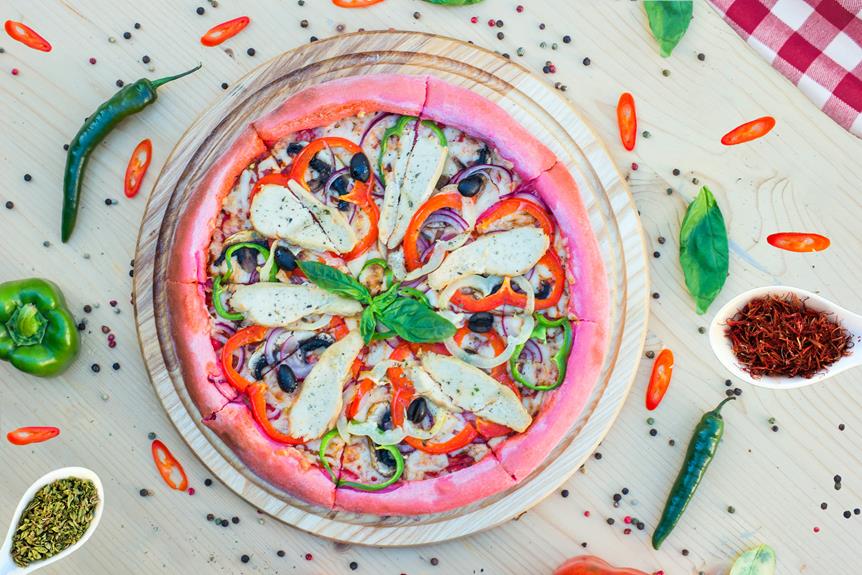Do you ever find yourself staring at a frozen pizza, wondering if it's already cooked? Don't worry, we've all been there.
In this article, we will dive into the fascinating world of frozen pizza and unravel the truth behind its cooking process.
From understanding packaging labels to exploring different cooking methods, we will equip you with the knowledge to achieve the perfect slice every time.
So, grab a seat and get ready to embark on a pizza adventure like no other.
Understanding the Cooking Process
To understand the cooking process of frozen pizza, you need to know how it's prepared and what steps you need to take before enjoying a delicious slice.
Cooking time is an important factor when it comes to frozen pizza. It's crucial to follow the instructions provided on the packaging to ensure that your pizza is cooked thoroughly and evenly. The cooking time can vary depending on the size and thickness of the pizza, but typically ranges from 10 to 15 minutes.
Preheating your oven is also essential for achieving the best results. Preheating allows the oven to reach the desired temperature, which helps the pizza cook evenly and ensures a crispy crust.
Unveiling the Truth About Frozen Pizza
Discover the truth behind frozen pizza. There are common misconceptions about the nutritional value of frozen pizza that need to be addressed. While some may believe that frozen pizza is unhealthy and lacks nutrients, the reality is quite different.
Frozen pizza can actually provide a good amount of nutritional value. It typically contains essential nutrients such as carbohydrates, protein, and fats. Additionally, frozen pizza often includes toppings like vegetables and meats, which can further increase its nutritional content.
However, it's important to note that not all frozen pizzas are created equal. Some brands may use lower quality ingredients or add excessive amounts of salt and preservatives. It's therefore crucial to read the nutrition labels and choose brands that prioritize wholesome ingredients.
Decoding the Packaging Labels
When decoding the packaging labels of frozen pizza, you'll want to pay attention to the nutritional information provided on the back of the box. This information is crucial in analyzing ingredients and decoding nutritional information.
Start by checking the serving size, as it may differ from what you actually consume. Next, look at the calorie count per serving and the breakdown of macronutrients like fat, carbohydrates, and protein.
Keep an eye out for any added sugars or unhealthy additives. Additionally, take note of the vitamin and mineral content, as well as the presence of allergens. By carefully analyzing these details, you can make informed choices about the frozen pizza you consume.
Exploring Different Cooking Methods
When exploring different cooking methods for frozen pizza, you can use either the oven or the microwave to quickly and easily prepare a delicious meal. The oven is a popular choice because it gives the pizza a crispy crust and evenly melts the cheese.
Preheat the oven to 425°F (218°C) and place the frozen pizza directly on the middle oven rack. The cooking time will vary depending on the brand and size of the pizza, but typically it takes around 12-18 minutes. Make sure to check the packaging for specific instructions.
On the other hand, the microwave offers a faster cooking time, usually around 4-6 minutes. However, the crust may not turn out as crispy as it would in the oven. It's important to follow the manufacturer's instructions for microwave cooking to ensure the best results.
Whichever method you choose, always keep an eye on the pizza to avoid burning it.
Tips for Perfectly Cooked Frozen Pizza
To achieve perfectly cooked frozen pizza, follow these tips for maximizing flavor and texture:
- Preheat your oven according to the heating instructions on the package. This ensures that your pizza cooks evenly and thoroughly.
- Place the frozen pizza directly on the oven rack or use a pizza stone for a crispier crust.
- Avoid overcrowding the oven by cooking only one pizza at a time. This allows for proper air circulation and prevents the pizza from becoming soggy.
- Consider adding your own toppings to enhance the flavor. Some popular choices include fresh basil, sliced tomatoes, or a sprinkle of crushed red pepper flakes.
- Keep a close eye on the pizza while it cooks to prevent burning. The cooking time may vary depending on the thickness of the crust and the amount of toppings.

